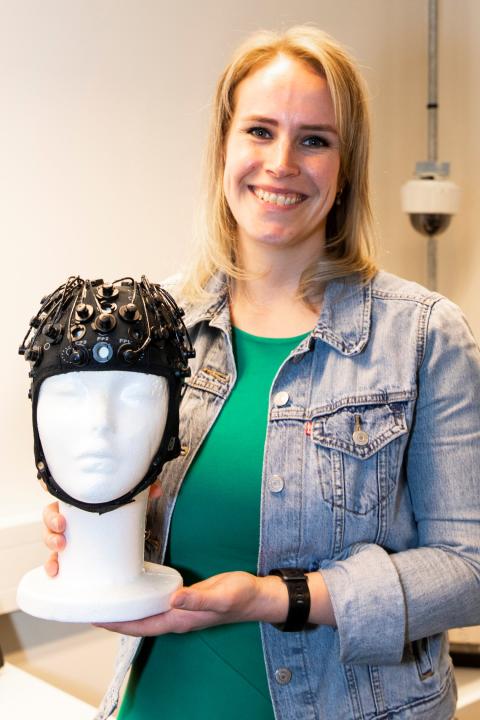GO-LAB unravels the interaction between body and mind
Consensus in scientific literature is strong: people who experience and for fear of rejection hide many negative emotions are irrefutably at a higher risk of contracting cardiovascular disease. But why are they? “Questionnaires are of little use in answering that question, but physical reactions reveal more than words,” says researcher Stefanie Duijndam. At Tilburg University, she is in charge of GO-LAB. Here, using heart rate and blood pressure monitors, infrared brain scans, skin conductors, and facial recognition, attempts are made to methodically and objectively analyze how the mental and physical dimensions of people’s condition interact.
“GO-LAB was set up in 2015 to meet the need for objective measuring methods that can help explain psychological and psychosomatic complaints,” Stefanie relates. She has been involved in the lab right from the start and has made a name for herself as an expert in the Tilburg lab research community. She taught herself to use equipment and software, and she wrote most of the protocols. “Questionnaires completed by respondents themselves are a staple of psychological research, and while these give a good picture of personality traits and of how people experience health problems, they don’t answer the question why that is or how personality traits impact on physical condition. That is a complex matter, which in the lab we try to dissect using innovative technology and methods.”

We hope this approach will improve our understanding of the mechanisms that are involved in causing illness
Stefanie Duijndam | GO-LAB Tilburg University
Fake smile
Innovation isn’t slow in coming, and Tilburg University is at the forefront of developments. “A good example of innovative and unique technology we use here is the FaceReader. A camera records participants’ faces as they perform a task. Analyzing their facial expressions, the FaceReader software registers the participants’ emotions. Our findings are often revealing. For example, in one experiment we asked participants to recall a situation when they were really very angry with someone, and we also asked them to report the feelings their recall triggered. Yet although the participants reported experiencing anger, the FaceReader registered a happy emotion. People apparently and subconsciously try to mask their anger with a pretend smile. By also measuring physical responses, for example by using skin conductors, we can detect how emotions impact on the body. You can’t hide clammy hands.”
Uncomfortable
At the GO-LAB facilities a variety of equipment is used to measure a wide range of physical responses. It is mostly non-verbal communication that is observed: perspiration, body temperature, facial expression, heart rate, and blood pressure. Responses are triggered through cognitive and stress tests. “By exposing people to feelings of discomfort we aim to measure how the body responds. We hope this approach will improve our understanding of the mechanisms that are involved in causing illness. That is important, because there is so much we have yet to learn. For example, cardiovascular disease is often attributed to lifestyle, but that is not the only factor. By identifying other underlying risks, we can help people better.”
Get in line
To date, the lab has accumulated a sizeable collection of data, but as yet that is not widely known. What are the lab’s aspirations in this regard? “So far the measuring data we have gathered concern a healthy population. For example, we know that students with certain personality traits register a stronger response to stress and that may point to a higher risk of contracting cardiovascular disease at a later age. What we would like to know is whether a clinical population provides corroboration. Increased exposure of GO-LAB would be a good thing, because it is essential to collect this type of data and to establish whether reality bears out our lab findings. It takes time, too: technology enables us to collect large quantities of data fast, but processing takes a lot of time and human resources. And finally, we greatly enjoy doing what we do and talking about it! We’re not the only ones to think so: at Night University, the line of people waiting to visit the lab stretches out onto campus.”
More information
The behavioral physiology research laboratory (Gedragsfysiologisch Onderzoekslaboratorium, GO-LAB) is part of the Medical & Clinical Psychology Department of the Tilburg School of Social and Behavioral Sciences (TSB). GO-LAB researchers study health effects of the interaction between emotions, behavior, mental disorders, and physical condition. GO-LAB is headed by Stefanie Duijndam and Nina Kupper. GO-LAB | Tilburg University
Date of publication: 19 January 2022
